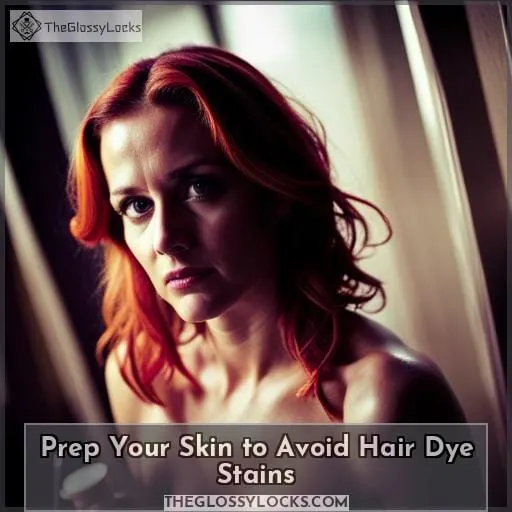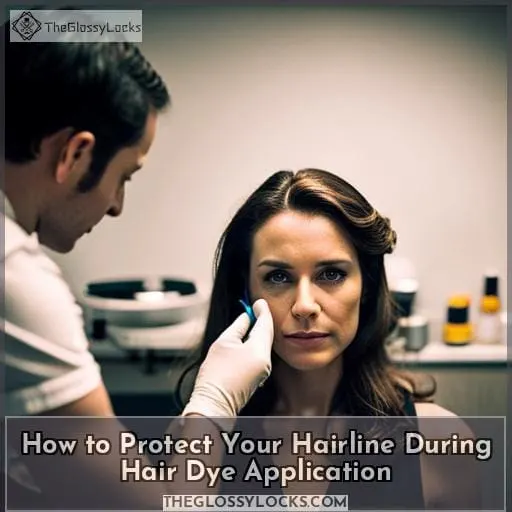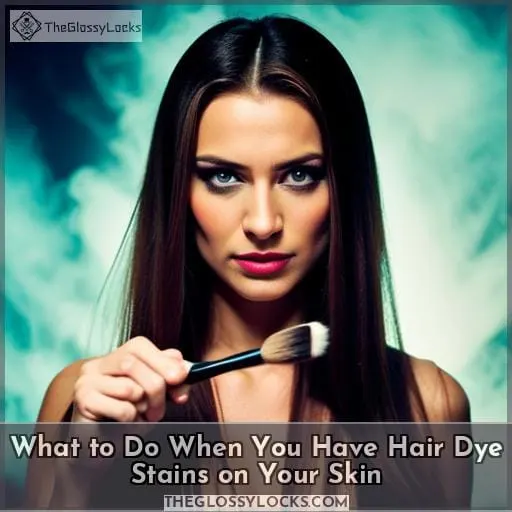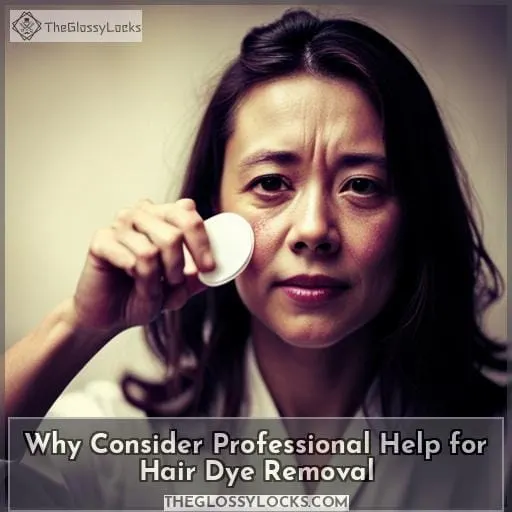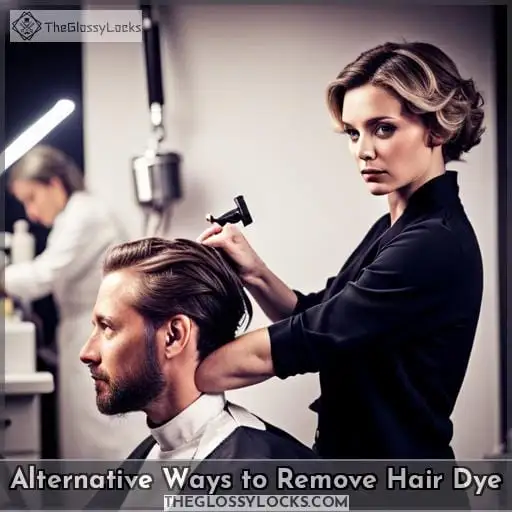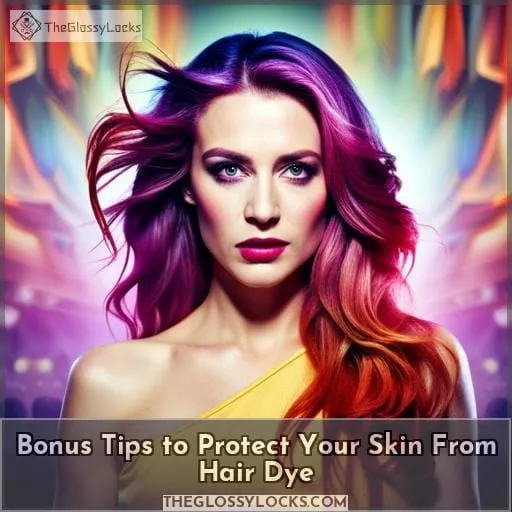This site is supported by our readers. We may earn a commission, at no cost to you, if you purchase through links.
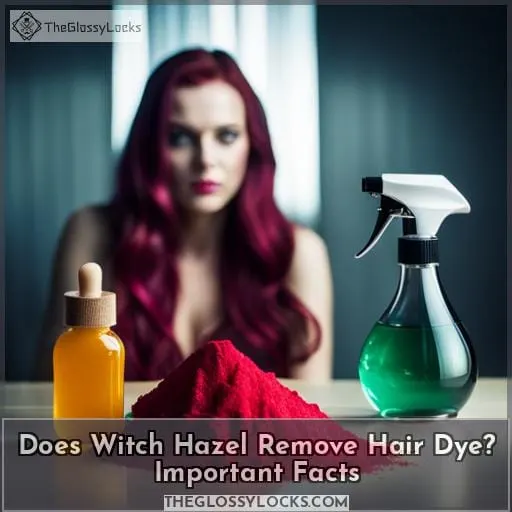 Struggling with how to remove hair dye from skin? While there is no scientific evidence that witch hazel will effectively take out semi-permanent or permanent dyes, many people swear by it as a natural method.
Struggling with how to remove hair dye from skin? While there is no scientific evidence that witch hazel will effectively take out semi-permanent or permanent dyes, many people swear by it as a natural method.
But does witch hazel really work for removing hair dye? Let’s explore the facts and find out what other methods are available.
Often hailed as an all-natural astringent, witch hazel can help soothe scalp inflammation and reduce oiliness – which makes it a popular recommendation when trying to get rid of stubborn stains on the skin left behind by hair colorants.
To answer this question, we need to look at how exactly you should use Witch Hazel if you want optimal results in getting rid of dyed hair without damaging your delicate facial areas nor putting yourself at risk for harm.
Table Of Contents
- Key Takeaways
- Does Witch Hazel Remove Hair Dye?
- Prep Your Skin to Avoid Hair Dye Stains
- How to Protect Your Hairline During Hair Dye Application
- What to Do When You Have Hair Dye Stains on Your Skin
- Why Consider Professional Help for Hair Dye Removal
- Alternative Ways to Remove Hair Dye
- Bonus Tips to Protect Your Skin From Hair Dye
- Conclusion
Key Takeaways
- Witch hazel contains tannins that can effectively remove hair dye stains.
- Thayers Rose Petal Toner, which contains witch hazel, can soothe and lighten hair dye stains.
- Professional help may be necessary for tailored hair dye removal and color correction.
- To prevent hair dye stains, protect the skin with petroleum jelly or Vaseline along the hairline during application.
Does Witch Hazel Remove Hair Dye?
Are you looking to remove your hair dye? Witch hazel may be the answer. Thayers Rose Petal Toner is an alcohol-free, soothing toner made with rose petal water, aloe vera, and proprietary witch hazel extract that has high therapeutic tannin levels for skin benefits.
Perfect for those seeking to incorporate a toner into their skincare routine, this product leaves skin refreshed and moisturized.
Thayers Rose Petal Toner
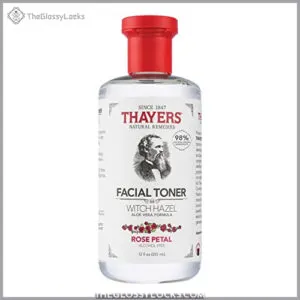
Try Thayers Rose Petal Toner to soothe and moisturize your skin while helping to lighten any stubborn hair dye stains. This alcohol-free toner is made with rose petal water, aloe vera, and proprietary witch hazel extract – perfect for those looking for a gentle solution that won’t dry out their skin.
Rich in Vitamin C, which helps promote collagen production and healthy skin cells, the high therapeutic tannin levels of this toner can provide calming benefits.
Multiple users have found it effective in reducing breakouts as well as soothing irritated areas on the face or elsewhere on the body caused by harsh hair dyes or other products.
- Alcohol-free formula soothes without drying out your skin
- Contains Witch Hazel extract, which cleanses and locks moisture into pores
- High therapeutic tannins provide calming benefits
- Slight tingling sensation may cause irritation in sensitive areas
- Soft rose scent might be too overpowering for some
First Aid Beauty Blemish Patrol Pads
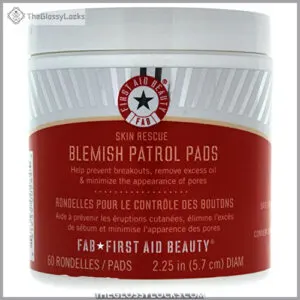
For those looking to lighten hair dye stains on their skin, First Aid Beauty Blemish Patrol Pads are a great option. One user reported that the pads helped reduce her acne scars and even out her skin tone without any drying effects.
The product is suitable for all skin types, including sensitive, and contains salicylic acid as an active ingredient, which can help with blackheads, cystic acne, and uneven tone.
Furthermore, it has been repurchased multiple times by users who find it effective in reducing breakouts while not causing additional dryness or irritation from daily use. The formula of these face pads also includes a calming hydrating complex that gently removes impurities while nourishing the skin at the same time.
- Effective for blackheads around the nose
- Contains salicylic acid as an active ingredient
- Suitable for all skin types (including sensitive)
- Helps with cystic acne & acne scars
- Generously loaded pre-packaged pads
- No drying or additional irritation effects
- May initially lead to more breakouts
- Slight tingling sensation upon application
- Not recommended if you want gentle exfoliation
Vaseline Petroleum Healing Jelly
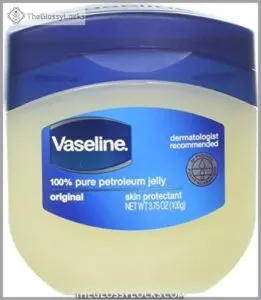
You can count on Vaseline Petroleum Healing Jelly to provide your skin with long-lasting comfort and nourishment! This all-purpose healing balm is triple purified for purity, fragrance-free, and hypoallergenic.
Its easy application makes it ideal for hydrating dry skin areas such as lips, elbows, knees, or feet.
Customers have found this product effective and versatile – many of them repurchasing after finding positive results from its use!
- Made with 100% pure petrolatum
- Triple purified formula ensures purity
- Fragrance-free & hypoallergenic
- Long-lasting & easy to apply
- Size of mini containers may be too small for some customers’ needs
- Price may not be worth the value received by some customers
- May contain allergens that could trigger sensitivities
Prep Your Skin to Avoid Hair Dye Stains
To protect your skin from hair dye stains, create a barrier with petroleum jelly or Vaseline along the hairline. For extra precaution, layer on a barrier cream for single strand highlights and semi-permanent dyes.
Make sure to have oil blotting paper handy too; this can help remove any excess dye that gets onto the face during application.
Last but not least, cover all exposed areas of skin with petroleum jelly once you’re done coloring your hair and before rinsing out the color – this will prevent staining as much as possible!
Witch hazel has been known to help lighten stubborn stains when used carefully; however, it is not recommended for use near colored strands since it could strip away some of their vibrancy and cause dryness or dullness in your mane.
How to Protect Your Hairline During Hair Dye Application
Before you begin dyeing your hair, protect your hairline by applying a barrier cream to avoid stains.
- Wear gloves when applying the dye to keep hands clean.
- Apply petroleum jelly or Vaseline along the edges of your hair before starting; this will create a barrier that helps prevent color from staining skin around it!
- Use shampoo around the scalp and rinse thoroughly after application so as not to reduce its effectiveness while removing excess product from any stray strands that may have made contact with the skin during the application process – reducing chances of staining occurring afterwards too!
- Rinse off remaining residue immediately with warm water if dye gets onto the skin during application; this should help minimize potential damage caused by prolonged exposure time to harsh chemicals found in some dyes such as hydrogen peroxide or ammonia-based products (which can cause further dryness/dullness).
- Finally, be sure not to use rubbing alcohols which could irritate delicate facial areas like eyes, etc., due to their high levels of astringency and acidity – opt instead for gentler solutions like witch hazel toners which contain soothing ingredients such as aloe vera and Vitamin C known for their anti-inflammatory properties while still being able to remove stubborn stain deposits without compromising the integrity/shine of the hair’s natural luster.
What to Do When You Have Hair Dye Stains on Your Skin
If you have hair dye stains on your skin, there are a few techniques that can help remove them. Organic coconut oil and lemon juice can be used to gently exfoliate the stained area. Baking soda paste helps dissolve stubborn pigment. Applying more hair dye may even out the stain.
Olive-based soap bars lift away color with minimal irritation, and witch hazel is known for its ability to reduce oiliness as well as lighten dyed areas.
Organic Coconut Oil
Consider using organic coconut oil to create a protective barrier before applying hair dye. It has multiple benefits for skin moisturization, hair care, and even cooking uses. Oil pulling is also an effective way to remove stubborn dye stains from your skin, while witch hazel can lighten them.
Organic coconut oil comes with many advantages: it’s natural and cruelty-free, plus free of harsh chemicals that might damage the scalp or cause irritation on the skin when applied topically as a protective layer against hair dyes.
Its anti-inflammatory properties help soothe redness and inflammation caused by prolonged contact with chemical compounds in some commercial products used for coloring tresses, like hydrogen peroxide or ammonia.
Lemon Juice and Baking Soda Paste
Mixing lemon juice and baking soda into a paste can help exfoliate stubborn dye stains from your skin. This technique is effective in removing hair color, as the acidic properties of lemon juice dissolve pigments while baking soda acts as an alkaline scrub to lift away dried residue.
When used carefully, this method can remove unwanted hair dye without further damaging the locks or irritating sensitive skin.
Using More Hair Dye
If your hair dye stains aren’t fading, you may need to apply another layer of color. Refresh the longevity of your hue by using a semi-permanent dye every few months. Try these methods to keep it vibrant: rinse with cold water after shampooing; use protective creams before each application; avoid harsh chemicals like hydrogen peroxide and ammonia.
Olive-Based Soap Bar
Try exfoliating your skin with an olive-based soap bar to gently break down any stubborn dye stains.
- Cleaning the area without harsh chemicals or bleaching agents
- Moisturizing and nourishing the skin while removing dirt and impurities
- Treating acne, reducing oiliness, and balancing pH levels of the skin
- Soothing irritation caused by hair dye removal methods.
Witch hazel has traditionally been used for hair dye removal, but it can be drying to colored hair. Olive-based soap is a gentler option that will also help keep your scalp healthy.
With its natural antibacterial properties, multipurpose healing balms like Vaseline Petroleum Healing Jelly are great for treating dyed areas alongside other acne treatment options like First Aid Beauty Blemish Patrol Pads.
Skin-friendly toners such as Thayers Rose Petal Toner can complete this routine for refreshed-looking results!
Witch Hazel
Wipe away those stubborn hair dye stains with the power of witch hazel! It’s a natural remedy that has skin and hair care benefits. Witch hazel can be used for DIY remedies, from removing makeup to fading dye stains.
Be sure to use it carefully – side effects include dryness or dullness in colored strands.
Why Consider Professional Help for Hair Dye Removal
Are you looking to achieve a certain hair color but don’t know if at-home dyes will provide the tailored results you need? Professional help can benefit those who want the best possible outcome for their hair dye removal.
With professional expertise, you’ll get access to personalized colors that are sure to give you your desired look – and without risking any potential damage from harsh at-home products.
Benefits of professional expertise
For a more professional and tailored hair dye removal solution, seeking out an expert is the way to go. Salons provide color correction services and consultations for desired looks. Professional advice can help avoid further damage that may result from over-the-counter products or incorrect application of dyes.
With their expertise in understanding complex formulas, stylists can guarantee gray coverage without sacrificing hair health or the vibrancy of color.
Tailored color and results
When it comes to hair dye, professional help is key for tailored color and results that can’t be replicated at home. A stylist can provide advice on the maintenance of hair dye as well as alternative techniques such as color fading to extend the longevity of the look.
They are also knowledgeable in how hair dyes interact with the skin, aiding in the prevention and remedying of any potential staining problems.
Considerations for at-home dyes
Before you try to dye your hair at home, consider the strength of the dye and its ability to provide gray coverage. Tips for successful results include: always use gloves. Apply a barrier cream along the hairline.
At-home dyes can be stronger but may not yield desired results or cover grays completely. Avoid using witch hazel as it can strip away color and dry out strands. Instead, opt for safe ingredients like hydrogen peroxide, baking soda, lemon juice, vinegar, or dish soap with baking soda to scrub off any remaining stains on the skin without irritation or damage to hair follicles.
Color maintenance is easier when seeking professional help. Due diligence must be taken when using at-home dyes by following all safety precautions, including wearing gloves.
Alternative Ways to Remove Hair Dye
If you’re looking for alternative ways to remove hair dye, a few options include using clarifying shampoo, baking soda, vitamin C, and vinegar. Clarifying shampoos are formulated with surfactants that help break down the pigment of semi-permanent dyes, while baking soda’s alkaline properties can help lighten color.
Crushed vitamin C tablets mixed with warm water may also be effective in helping fade hair dye, but it isn’t guaranteed to completely remove it. Lastly, using an acidic solution such as vinegar or lemon juice has been known to dissolve stubborn stains when used properly.
Clarifying Shampoo
Clarifying shampoo with surfactants can gradually fade hair dye, so give your strands a gentle cleanse for subtle color changes. Use it regularly to minimize damage and restore natural tones or remove unwanted pigment from dyed hair.
Witch hazel is not recommended as it may dry out locks, but other methods such as baking soda and vinegar are safe alternatives to help lighten color without harsh chemicals. Protect your skin by wearing gloves when dyeing and using petroleum jelly along the hairline before rinsing out excess product for smooth results.
Baking Soda
To lighten hair color, baking soda is an effective alternative. Its alkaline properties break down semi-permanent dyes in 10 minutes. Use a paste of water and baking soda to gently exfoliate dye from the skin; lemon juice’s acidic property helps dissolve stubborn stains too.
Vitamin C
Crush vitamin C tablets, mix them with warm water, apply, and rinse for a lighter hair color. Vitamin C offers many benefits to the skin and hair; it can help lighten dye while nourishing the scalp. Keep in mind that it may not completely remove dye from strands but will be effective in fading out pigmentation over time.
Vinegar
Mixing vinegar with warm water or lemon juice can help fade hair dye. Benefits include reducing the longevity of dye, DIY stain removal, and skin care after dyeing. Witch hazel may remove it from the skin but not hair; it could strip color and dry out strands.
Bonus Tips to Protect Your Skin From Hair Dye
You can easily protect your skin from hair dye stains by using a barrier cream before applying the dye. To further prevent any residue buildup, wear gloves and old clothing while working with hair color products.
Additionally, consider investing in a quality toner such as Thayers Rose Petal Toner or First Aid Beauty Blemish Patrol Pads to help soothe irritated areas after coloring.
Here are some bonus tips for protecting your skin:
- Use Vaseline Petroleum Healing Jelly to create an extra layer of protection against residues on the scalp and along the hairline before starting to apply color.
- Make sure you rinse off all traces of product with cold water once you’re finished dying; this will close up cuticles that may have been opened during application, preventing staining agents from seeping into pores and onto surrounding skin cells.
- Invest in quality clarifying shampoos with surfactants designed specifically for removing stubborn dyes; these can gradually fade away pigment without causing damage to delicate strands or irritating sensitive scalps!
Finally, always check product labels for ingredient changes prior use since they may contain harsher chemicals than anticipated which could cause more harm than good – even if it’s just supposed temporary!
Conclusion
You may be wondering if witch hazel can effectively remove hair dye from your skin and hair. The short answer is, yes—in some cases. Witch hazel, which contains high levels of tannins, can be used to remove stubborn hair dye stains from the skin.
Products like Thayers Rose Petal Toner and First Aid Beauty Blemish Patrol Pads are formulated with witch hazel and can help remove dye. It is also important to be mindful of the ingredients in hair dyes and use products without harsh chemicals like hydrogen peroxide and ammonia to avoid further damage to hair.
Additionally, a combination of clarifying shampoo and baking soda can be used to gradually fade hair color. In the end, using witch hazel to remove hair dye is possible, but it is important to proceed with caution.

